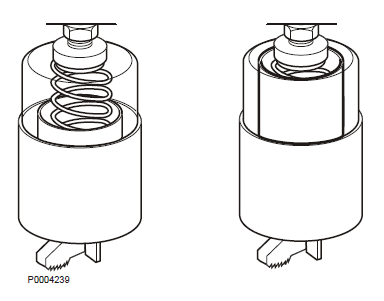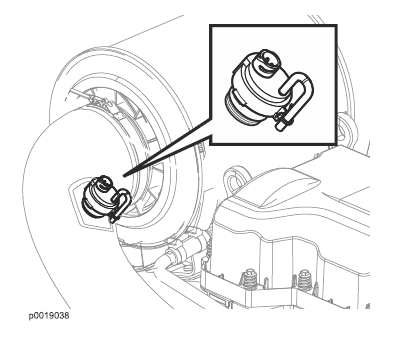Volvo Diesel Engine Filter Categories
Categories
Filtration categories
Air filters are usually divided into three filtration categories. The choice of filter type depends on the area of application, dust concentrations where it will operate and required service life. The three filtration categories are shown below together with information about their use. Note that these guidelines are only recommendations and that it may be necessary in certain situations to use a filter suited to conditions dustier than those specified.
Air filter for minor dust quantities (dust concentration 1–5 mg/m3)
Usually installed directly on the inlet manifold and generally without a pre-cleaner.
Used in: a highway vehicle applications in countries with temperate climates, i.e. where dust concentrations are low. b industrial installations for driving in sheltered conditions and in areas with low dust concentrations.
Typical air filters in this category are dry filters (paper elements) without pre-cleaners and with only moderate dust collection capacity.
Air filter for medium dust quantities (dust concentration 5–20 mg/m3)
Usually installed directly on or a little way away from the engine; generally has an internal or external precleaner. Used in:
a highway and terrain vehicle applications in countries with temperate climates and drier climates, i.e. where dust concentrations are moderate.
b general industrial applications.
c all normal agricultural applications.
Typical air filters in this category are dry filters with integral centrifugal pre-cleaners with greater dust collection capacity than air filters for low dust quantities described above.
Air filter for large dust quantities (dust concentration 20–100 mg/m3)
This filtration category usually includes high-efficiency pre-cleaner devices which in some cases are emptied of dust automatically.
Used in:
a terrain vehicle applications where dust concentrations
are extreme, e.g. in quarries, ground preparation etc.
b earth graders, industrial equipment, stone
crushers and chippers.
c agricultural equipment designed for operations in extremely dusty conditions.
IMPORTANT!
If a customer requires a special air filter that is not included in the Volvo Penta Sales Support Tool,
Partner Network the customer is entirely responsible for correct layout and installation. If the engine is damaged due to mistakes in the layout or installation of the air cleaner system, Volvo Penta will deny any claims made against the engine warranty.
Inlet pipe, after filter
Inlet system pipes and their associated attachments must be checked thoroughly in order to minimize flow restrictions and to ensure that seals remain reliable throughout the operational conditions the engine is exposed to during use.
NOTICE! It is absolutely essential that all pipes are thoroughly cleaned and have their internal surfaces correctly treated to prevent rust particles and foreign materials from welding entering the engine. The surface must be dip painted, zinc dipped or galvanized. In order to minimize flow restrictions in the system, the pipes must be as short and have as few bends as possible.
NOTICE! No pipe cross-sectional areas may be smaller than the cross-sectional area of the inlet manifold opening.
Fixed pipes
The pipes may be of steel, aluminum or molded plastic but the internal surfaces must under all circumstances be smooth and free from defects. Pipe ends used together with hose connectors must be perfectly round and have an even surface along at least 50 mm (2") of pipe at every connection. Pipe walls must be thick enough not to be deformed by the pressure from hose clamps. All pipes must ideally have end flanges to improve sealing and allow hoses to be fastened more securely.
Hoses
Smooth, i.e. unreinforced hose sections may only be used to join parts of fixed pipes etc. that are located in line and close to each other, and where there is little relative movement. A short section of reinforced, flexible inlet hose may be used where two parts that are not in line must be joined and it is not possible to use a cast bend or similar part. The same applies where sections with large relative movement must be joined. The inlet hose, after the filter, must be designed to handle pressures according to technical data in Sales Support Tool, Partner Network.
General installation remarks
Pressure drop across the air filter
An air filter's dust collection capacity depends largely on engine air requirement and the filter's filtration category. Dust collection capacity is defined as the amount of dust a filter can collect before flow restriction becomes so great that the filter must be replaced. The maximum permissible pressure drop from the air inlet to the turbocharger inlet is specified in the Industrial Sales Guide under "Inlet and exhaust systems" for each engine.
NOTICE! The pressure drop refers to an engine at full load and maximum revolutions.
In order to fulfill the pressure drop requirement we recommend that:
- the pressure drop across the air strainer, check technical data.
- the pipes are dimensioned for a maximum air velocity of 25 m/s (82 ft./s).
NOTICE! Never try to clean a dirty dry filter by shaking it, striking it on the floor or by using compressed air. This can cause the filter element to come loose in the
filter resulting in leakage. Dry filter installations equipped with limit indicators
need only be changed when so shown on the indicator. Extreme care must be taken when changing filters to prevent dust entering the inlet system. All connections and seals must be checked and replaced if necessary.
Pressure drop indicator
We strongly recommend that a pressure limit indicator only be installed for dry filters. If an inlet system other than Volvo Penta's is used on the engine installation, the pressure drop indicator must be located as close to the turbocharger inlet as possible. This is done to ensure that the pressure drop caused by the inlet system pipe is also taken into account. In this way the filter element will attain as long a life as possible without exceeding the max value for engine flow limitation, while also preventing premature filter change. Check the pressure drop indicator daily before engine start. Change the filter as soon as the entire red field is visible in the window.


Example
The illustration shows a temperature and pressure sensor. This is supplied upon selection of the Volvo Penta air filter. If a different air filter is selected the sensor must be installed according to the instructions in the kit.
NOTICE! The sensor must be installed and connected for exhaust gas cleaning to function correctly.
For More Volvo Engine workshop information, please visit
Copyright © Guangxi Dingbo Generator Set Manufacturing Co., Ltd. All Rights Reserved | Sitemap
Update cookies preferences